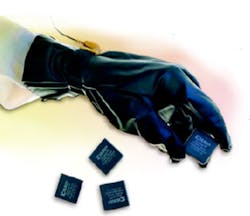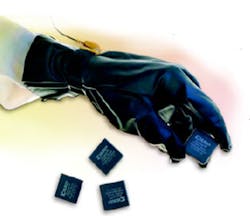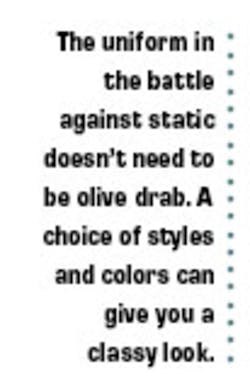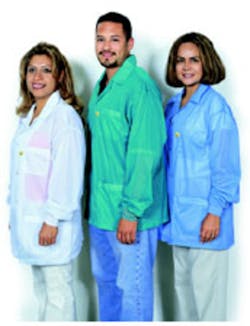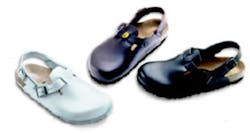While the ESD Association Standard ANSI/ESD S20.20-1999 doesn’t require them in every application, ESD-protective outer garments are recommended for supplemental protection in some ESD control programs. The item used most frequently is the smock, but the category includes coveralls, coats, complete suits, caps, booties, and face masks.
S20.20 specifies that all processessential insulators with electrostatic fields exceeding 2,000 V should be kept at least 12″ from ESD-susceptible items if considered a threat. Normal garments, particularly those made from synthetic fibers, are insulators, they are likely to be within 12″ of the product being manufactured or moved, and they can have static charges as great as 2,000 V.
Worse yet, untreated fabric can’t be grounded because it’s an insulator. This is the reason thatSmocks
A garment such as a smock must be antistatic so it doesn’t develop a tribocharge. The protective material creates a Faraday-cage effect, keeping charges generated by the regular clothing inside the smock. The material should be dissipative so grounding will remove any charge that accumulates, and it needs a ground strap.
“The most critical aspect of garment manufacture,” according to Gene Felder, corporate marketing manager at Desco, “is maintenance of panel-topanel conductivity. The carbonized nylon filaments must be connected to maintain the static protection. A garment can be tested for joint validity by placing 5-lb electrodes on separate panels and measuring the resistance between them.
“Another test determines the tribocharging characteristic,” he continued. “After the garment is placed on and separated from other materials, the static charge can be measured on a field meter.
The same meter can check the garment’s shielding effect. An object is charged, and the voltage is measured from a given distance. Then the garment is placed over it for a second reading from the same distance. The difference in readings indicates the Faraday-cage effect.”
In addition to ESD protection, an employee who wears a garment for eight hours each day, week after week, still wants to be proud of his or her appearance. “We listen to our customers when designing new garments or improving older styles,” noted Chris Adams, sales support at Tech Wear. “We have five distinct garment styles, three different lengths, and five fabric selections in a broad selection of colors.”
ESD-Safe Shoes
Routine movement of people and materials through the work environment is the principal cause of static electricity. While the wrist strap is the first line of defense in personnel grounding, many employees involved in electronic production must move about to do their jobs. Wrist straps are impractical if not impossible for those people. Also, wrist-strap performance depends on good skin contact and proper electrical connections.
For these reasons, ESD footwear on a static-control floor or mat is the second line of defense against electrical charges. This can include disposable or semipermanent heel and toe grounders or shoe covers, disposable booties, or shoes. Many companies mandate that all employees who travel into a sensitive area must wear ESD-safe shoes at all times. Disposable or semipermanent footwear is available for visitors.
To meet the total footwear needs for employees required to wear static-control shoes, a variety of factors other than staticcontrol characteristics plays an important role. Shoes must be provided in a range of men’s and women’s sizes or the employees will fight wearing them. Then there are style preferences. Also, personnel who spend most of their time in the office generally want styles appropriate to that environment, yet ESD-safe for occasional trips to the production area or stockroom. Finally, some people need features such as steel toes while others do not.
“Wearing the proper shoes is a start toward personnel grounding,” Nico Katan, managing director at Shico Industrial Footwear, said, “but there are factors that modify the benefits of the shoes. For example, socks can make a difference. Most socks are insulators, but after a normal body temperature is reached, body moisture makes them conduct static charges. Generally, plain woolen or cotton socks perform well, and the small number of people whose feet do not perspire much should consider using them rather than socks made of synthetic fibers.”A factor over which you have little or no control is the workplace environment, specifically the humidity. For example, it is easier to control ESD in the damp climate of Florida than the dry air of Nevada. Recognizing this variable, some manufacturers specify ESD characteristics as applicable in a specific range of relative humidity. “Our shoes have a resistance of from 5 MΩ to 15 MΩ at 45% to 60% RH,” according to Mr. Katan.
Clean-Room Protection
In the clean room, contamination control obviously has an extremely high priority. Even though users recognize that ESD problems could be lurking there, particulate contamination is more an issue than static contamination.
“Fortunately, ESD-safe garments in the clean room are not necessarily incompatible with cleanliness,” according to Brad Jubin, president of terrafirma representing TW Clean. “Low-contaminant fabrics are used in garments made by our company, and our test results validate low contamination and proper ESD control, even after 100 washes. The twill weave of polyester and carbon has a dual grid pattern at 7-mm intervals to protect against uncleanliness and static buildup.”
For More Information
For more information on this topic, visit our website at www.evaluationengineering.com and access the Article Archives.
ESD Apparel
Lightweight Smock
The Statshield® Protective Smock made of lightweight dissipative material incorporates 88% texturized polyester with 12% carbon-suffused nylon monofilament. The surface resistivity is 105 Ω to 106 Ω, and a 5,000-V static charge decays to 500 V in less than 0.1 s. A grounding stud at the hip connects to the metallized fabric and conductive elastic cuffs. The garment can be provided as either a coat or a jacket, each in 10 sizes and three colors. Desco, 909-627-8178, www.rsleads.com/204ee-176
Gloves and Finger Cots
An assortment of finger cots and left-hand and right-hand fabric gloves can be used when inspecting, manufacturing, and packaging sensitive parts. Standard gloves and liners come in the SG configuration with heat-grip silicone embossment and as PU gloves with polyurethane palms. The newest rolled finger cots are thick and heavy for use with equipment with sharp edges, and the nitrile cots are used in clean areas where natural rubber latex is unsuitable. Renco, 800-257-8284, www.rsleads.com/204ee-177
Footwear
The line of ESD Shoes is available in all standard sizes and a choice of styles. Most models have soft toes, but some feature steel toes rated at 200 joules, while others offer a composite protector rated at 100 joules. The resistance is 5 MΩ to 15 MΩ at a humidity level of 45% to 60%. The soles are nitrile rubber with an antiskid rating of 0.63 for dry surfaces and 0.55 on wet floors. The shoes resist oil and alkali. Shico Industrial Footwear, 011 44 1933 273800, www.rsleads.com/204ee-178
Polo Shirt
The Ground Hero ESD Polo Shirt is made of a blend of 93% Crestlite™ acrylic fabric and 7% Conductrol™. Each short-sleeved shirt weighs about 9 oz and has a breast pocket, front-button placket opening, double-needle hem, and side vents. Surface resistance is 105 Ω to 107 Ω at 50% RH and 21°C. The shirts meet the ESD Association’s STM2.1-1997 for a minimum of 100 washes. Tech Wear, 760-438-7788, www.rsleads.com/204ee-179
Fingercots
The 8C Static-Dissipative Fingercots are used to handle Class I and Class II static-sensitive devices. They have an average surface resistance of 1 × 107 Ω and dissipate induced charges in <0.25 s. Packed in ESD-safe inner and outer wrappers to ensure against triboelectric charge buildup or generation, the products are suitable for use in clean rooms. The sheerfilm fingercots come in small, medium, and large sizes. QRP, 520-790-3533, www.rsleads.com/204ee-180
Shoes
Tokyo Clogs are ESD-safe shoes with rivets and special soles that dissipate static charges. The smooth leather shoe has straps that adjust for comfort and a suede-lined, cork/latex footbed. Birkenstock Footprint Sandals, 415-892-4200, www.rsleads.com/204ee-181
Clean-Room Garments
Ground Zero Garments are suitable for use in a clean-room environment. They provide a verifiable path to ground for the wearer as well as the clothing. The dual-conductor version interfaces with a resistive loop or charge-detection continuous monitor or allows you to use conventional verification of grounding. The line includes F Series and L Series Smocks, B Series Coveralls, H Series Head Covering, and Booties. TW Clean, 770-632- 1774, www.rsleads.com/204ee-182
April 2002
